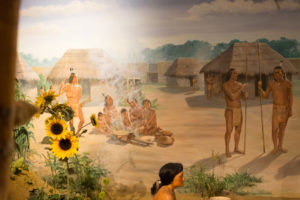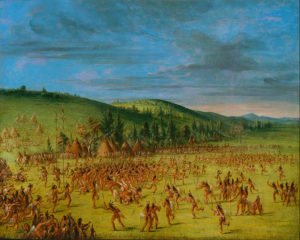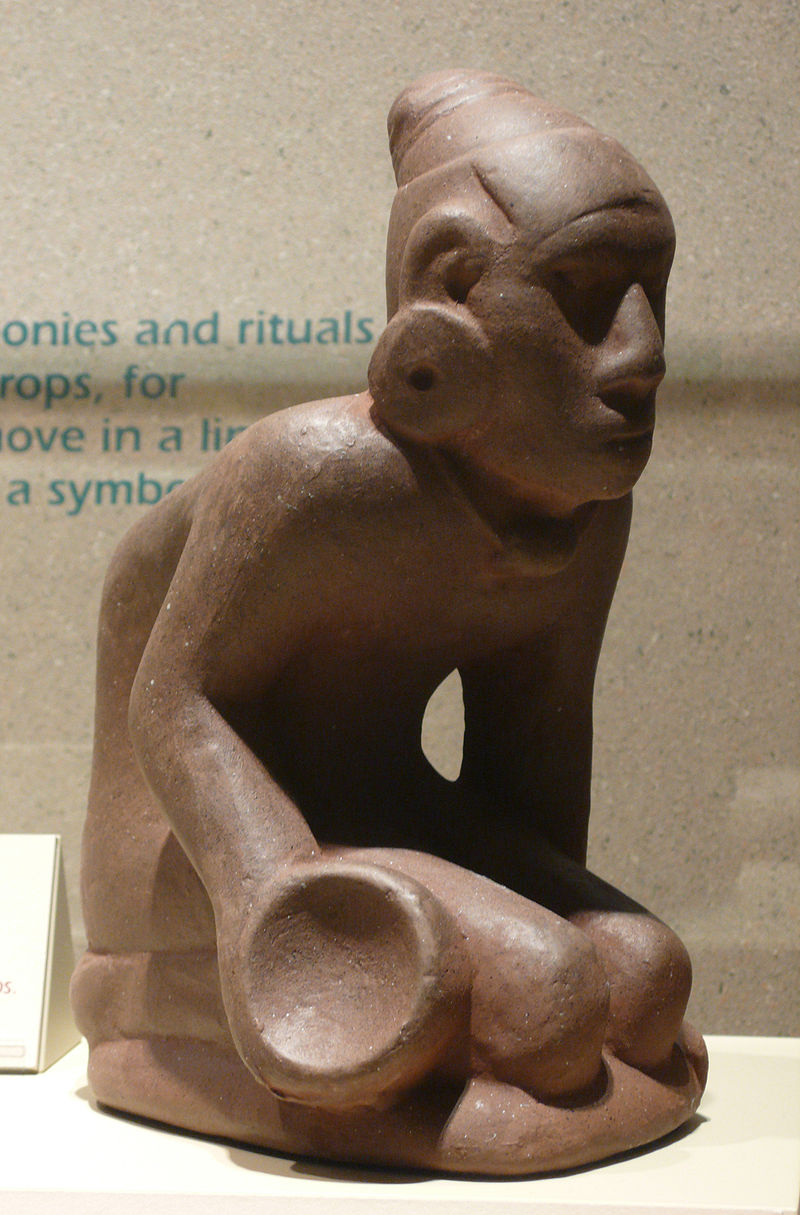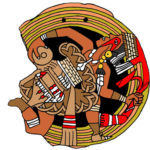As mentioned in the Natchez Calendar, the Mississippian new year began on the new moon of the early spring (roughly equivalent to mid-March). Celebrated with magnificent festival called The Feast of the Deer, it lasted for several days and involved many different feats and festivities.
 Several 18th century French annalists who were privileged to witness this celebration described it through their own cultural lens as religious and political event: religious because the celebration was meant to thank the Great Spirit or Spirits, and political because at the time of such major festivals people brought their bi-yearly tribute to the Great Sun, the ruler.
Several 18th century French annalists who were privileged to witness this celebration described it through their own cultural lens as religious and political event: religious because the celebration was meant to thank the Great Spirit or Spirits, and political because at the time of such major festivals people brought their bi-yearly tribute to the Great Sun, the ruler.
The first day of the celebration was marked with historical reenactment of great detail and investment. According to the ancient legend, once upon a time, an ancient great sun heard great tumult in his main village. Having come out to investigate the matter, he had fallen “… into the hands of a hostile nation which had come to surprise them …” However the warriors of the village, sleepy and surprised that they were, had managed to put up a decent fight and so recapture their sovereign and cause the enemy to flee ignobly. And this was the event every new year celebration recalled.
According to Du Prutz, before the festivities started the men of the village separated themselves into two bodies distinguished by the color of their outfits. One party would wear white plumes, while the other, the one that represented the enemy, would adorn themselves with red decorations.
“… Both bands would place themselves in ambush near the house of the Great Sun, advancing with ceremonial cries and dances. When it was time their ruler would come out, dressed lavishly in the best of the festive apparel but rubbing his eyes as though having woken from sleep. At this moment, the “enemy” would throw themselves upon him, endeavoring to pick the sacred man up and start carrying him away, while the band representing the defenders rushes out and snatches him from their hands …”
“… This action takes place without any accident on either side and without quarrels, but not without noise… The cries of the enemy are cries of death while attacking; those of the nation attacked are cries of fear and terror. The enemy nation continues the cries of death as long as the ruler is in their hands… Both make many movements that denote the stratagems of war, which lasts half an hour. During this time the Great Sun defends himself with a war club of an ancient pattern. He knocks down the great number of enemy without, however, touching them …”
The reenactment lasted until the old ruler was recaptured, then the warriors representing the Natchez would “strike down” the rest of the enemy, some of which would fake fall while others would flee and be chased up to the edge of the settlement and the beginning of the woods, their cries not of death now but of terror now.
 Then everyone would return back to the main square and burst out along with the ruler and the spectators in cries of joy that would “… reverberate the air… ”
Then everyone would return back to the main square and burst out along with the ruler and the spectators in cries of joy that would “… reverberate the air… ”
The Great Sun, having been led back to his cabin, would retire for a short rest, being usually a man of advanced years for the rigors of such performance not to take their toll on him. The warriors representing the enemy would reenter the crowds in the meanwhile, pretending that they didn’t know of the fate of their sovereign. It was their demand to be shown the Great Sun hale and healthy that would bring the ruler back out, emerging free of some of his regalia and without the crown.
Amidst general cries of joy at his appearance, the Great Sun would take the path leading this time toward the temple, the crowd following him in a quieter fashion. Pausing in front of the house of worship he would bend very low without bending his knees, take a little earth and throw it upon his head, then turn to all four directions repeating the ritual (the temple was usually facing the south). For a long time (as long as half an hour, according to Du Prutz) he would remain so, gazing at the temple, his arms extended horizontally and no other movement to enliven his pose “… until the grand master of the ceremony comes to relieve him …” himself repeating the same ritual until replaced by the war chief and so on.
 In the meanwhile, the Great Sun goes back to his cabin and comes out of it clad in his previous regalia, the crown of feathered diadem with necklace of pearls and feathers hanging from it, his shoulders cover with beautifully patterned skins, his feet adorned with peltries. His seat of honor, a piece of furniture made out of a single chunk of wood and covered with more beautifully patterned skins ornamented with different designs, is brought into the middle of the square where the feast was already being laid out. Women present him with generous offerings while uttering cries of joy and the last who brings them terminates the feast.
In the meanwhile, the Great Sun goes back to his cabin and comes out of it clad in his previous regalia, the crown of feathered diadem with necklace of pearls and feathers hanging from it, his shoulders cover with beautifully patterned skins, his feet adorned with peltries. His seat of honor, a piece of furniture made out of a single chunk of wood and covered with more beautifully patterned skins ornamented with different designs, is brought into the middle of the square where the feast was already being laid out. Women present him with generous offerings while uttering cries of joy and the last who brings them terminates the feast.
Comments
No Comments to “Feast of the Deer or Happy New Year”